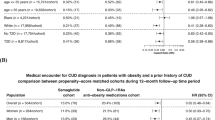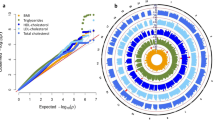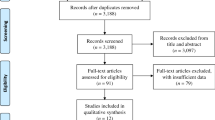Abstract
Concerns over reports of suicidal ideation associated with semaglutide treatment, a glucagon-like peptide 1 receptor (GLP1R) agonist medication for type 2 diabetes (T2DM) and obesity, has led to investigations by European regulatory agencies. In this retrospective cohort study of electronic health records from the TriNetX Analytics Network, we aimed to assess the associations of semaglutide with suicidal ideation compared to non-GLP1R agonist anti-obesity or anti-diabetes medications. The hazard ratios (HRs) and 95% confidence intervals (CIs) of incident and recurrent suicidal ideation were calculated for the 6-month follow-up by comparing propensity score-matched patient groups. The study population included 240,618 patients with overweight or obesity who were prescribed semaglutide or non-GLP1R agonist anti-obesity medications, with the findings replicated in 1,589,855 patients with T2DM. In patients with overweight or obesity (mean age 50.1 years, 72.6% female), semaglutide compared with non-GLP1R agonist anti-obesity medications was associated with lower risk for incident (HR = 0.27, 95% CI = 0.200.32–0.600.36) and recurrent (HR = 0.44, 95% CI = 0.32–0.60) suicidal ideation, consistent across sex, age and ethnicity stratification. Similar findings were replicated in patients with T2DM (mean age 57.5 years, 49.2% female). Our findings do not support higher risks of suicidal ideation with semaglutide compared with non-GLP1R agonist anti-obesity or anti-diabetes medications.
This is a preview of subscription content, access via your institution
Access options
Access Nature and 54 other Nature Portfolio journals
Get Nature+, our best-value online-access subscription
$29.99 / 30 days
cancel any time
Subscribe to this journal
Receive 12 print issues and online access
$209.00 per year
only $17.42 per issue
Buy this article
- Purchase on Springer Link
- Instant access to full article PDF
Prices may be subject to local taxes which are calculated during checkout




Similar content being viewed by others
Data availability
This study used population-level aggregate and de-identified data collected by the TriNetX Platform, which are available from TriNetX (https://trinetx.com/); however, third-party restrictions apply to the availability of these data. The data were used under license for this study with restrictions that do not allow for data to be redistributed or made publicly available. To gain access to the data, a request can be made to TriNetX (join@trinetx.com), but costs might be incurred and a data-sharing agreement would be necessary. Data specific to this study, including diagnosis codes and group characteristics in aggregated format, are included in the paper as tables, figures and supplementary files.
Code availability
All the statistical analyses in this study, including propensity score matching and Kaplan–Meier survival analyses were conducted using the TriNetX platform with its built-in functions. The data and code needed to reproduce the analyses can be accessed at https://github.com/bill-pipi/semaglutide_suicide.
References
Ilic, M. & Ilic, I. Worldwide suicide mortality trends (2000–2019): a joinpoint regression analysis. World J. Psychiatry 12, 1044–1060 (2022).
Suicide (WHO, 2023); www.who.int/news-room/fact-sheets/detail/suicide
Suicide in the World: Global Health Estimates (WHO, 2019); apps.who.int/iris/bitstream/handle/10665/326948/WHO-MSD-MER-19.3-eng.pdf
Suicide Data and Statistics (CDC, 2023); www.cdc.gov/suicide/suicide-data-statistics.html
Findlay, S. Health policy brief: the FDA’s sentinel initiative. Health Affairs www.healthaffairs.org/do/10.1377/hpb20150604.936915/ (2015).
Gibbons, R., Hur, K., Lavigne, J., Wang, J. & Mann, J. J. Medications and suicide: high dimensional empirical Bayes screening (iDEAS). Harvard Data Sci. Rev. https://doi.org/10.1162/99608f92.6fdaa9de (2019).
Sam, A. H., Salem, V. & Ghatei, M. A. Rimonabant: from RIO to Ban. J. Obes. 2011, 432607 (2011).
Meier, J. J. GLP-1 receptor agonists for individualized treatment of type 2 diabetes mellitus. Nat. Rev. Endocrinol. 8, 728–742 (2012).
Vilsbøll, T., Christensen, M., Junker, A. E., Knop, F. K. & Gluud, L. L. Effects of glucagon-like peptide-1 receptor agonists on weight loss: systematic review and meta-analyses of randomised controlled trials. BMJ 344, d7771 (2012).
Singh, G., Krauthamer, M. & Bjalme-Evans, M. Wegovy (semaglutide): a new weight loss drug for chronic weight management. J. Investig. Med. 70, 5–13 (2022).
Haddad, F., Dokmak, G., Bader, M. & Karaman, R. A comprehensive review on weight loss associated with anti-diabetic medications. Life 13, 1012 (2023).
EMA Statement on Ongoing Review of GLP-1 Receptor Agonists (EMA, 2023); www.ema.europa.eu/en/news/ema-statement-ongoing-review-glp-1-receptor-agonists
Chiappini, S. et al. Is there a risk for semaglutide misuse? Focus on the Food and Drug Administration’s FDA Adverse Events Reporting System (FAERS) pharmacovigilance dataset. Pharmaceuticals 16, 994 (2023).
Christensen, R., Kristensen, P. K., Bartels, E. M., Bliddal, H. & Astrup, A. Efficacy and safety of the weight-loss drug rimonabant: a meta-analysis of randomised trials. Lancet 370, 1706–1713 (2007).
Wilding, J. P. H. et al. Once-weekly semaglutide in adults with overweight or obesity. N. Engl. J. Med. 384, 989–1002 (2021).
Wegovy Pen Instructions (Wegovy, 2023); www.wegovy.com/taking-wegovy/how-to-use-the-wegovy-pen.html?gclid=Cj0KCQjw2eilBhCCARIsAG0Pf8tI7X1_NL8ZY2I7KFOkn2YrR24Og2sQBN_rB1jc1lXzCRwnLamdWLIaAu0OEALw_wcB&gclsrc=aw.ds
Klinitzke, G., Steinig, J., Blüher, M., Kersting, A. & Wagner, B. Obesity and suicide risk in adults—a systematic review. J. Affect. Disord. 145, 277–284 (2013).
Castaneda, D., Popov, V. B., Wander, P. & Thompson, C. C. Risk of suicide and self-harm is increased after bariatric surgery—a systematic review and meta-analysis. Obes. Surg. 29, 322–333 (2019).
Hung, A. et al. Bariatric surgery and suicide risk in patients with obesity. Ann. Surg. 278, e760–e765 (2023).
Cheung, B. M. Y., Cheung, T. T. & Samaranayake, N. R. Safety of antiobesity drugs. Ther. Adv. Drug Saf. 4, 171–181 (2013).
AbdElmageed, R. M. & Mohammed Hussein, S. M. Risk of depression and suicide in diabetic patients. Cureus 14, e20860 (2022).
Strain, T. et al. Impact of follow-up time and analytical approaches to account for reverse causality on the association between physical activity and health outcomes in UK Biobank. Int. J. Epidemiol. 49, 162–172 (2020).
Uzoigwe, C., Liang, Y., Whitmire, S. & Paprocki, Y. Semaglutide once-weekly persistence and adherence versus other GLP-1 RAs in patients with type 2 diabetes in a US real-world setting. Diabetes Ther. 12, 1475–1489 (2021).
Klonsky, E. D., Dixon-Luinenburg, T. & May, A. M. The critical distinction between suicidal ideation and suicide attempts. World Psychiatry 20, 439–441 (2021).
Wang, L., Wang, Q., Davis, P. B., Volkow, N. D. & Xu, R. Increased risk for COVID‐19 breakthrough infection in fully vaccinated patients with substance use disorders in the United States between December 2020 and August 2021. World Psychiatry 21, 124–132 (2022).
Wang, L. et al. Incidence rates and clinical outcomes of SARS-CoV-2 infection with the Omicron and Delta variants in children younger than 5 years in the US. JAMA Pediatr. 176, 811–813 (2022).
Wang, L., Davis, P. B., Kaelber, D. C., Volkow, N. D. & Xu, R. Comparison of mRNA-1273 and BNT162b2 vaccines on breakthrough SARS-CoV-2 infections, hospitalizations, and death during the Delta-predominant period. JAMA 327, 678–680 (2022).
Wang, L., Davis, P. B., Kaelber, D. C. & Xu, R. COVID-19 breakthrough infections and hospitalizations among vaccinated patients with dementia in the United States between December 2020 and August 2021. Alzheimers Dement. 19, 421–432 (2023).
Wang, W., Kaelber, D. C., Xu, R. & Berger, N. A. Breakthrough SARS-CoV-2 infections, hospitalizations, and mortality in vaccinated patients with cancer in the US between December 2020 and November 2021. JAMA Oncol. 8, 1027–1034 (2022).
Wang, L., Kaelber, D. C., Xu, R. & Berger, N. A. COVID-19 breakthrough infections, hospitalizations and mortality in fully vaccinated patients with hematologic malignancies: a clarion call for maintaining mitigation and ramping-up research. Blood Rev. 54, 100931 (2022).
Wang, L., Berger, N. A. & Xu, R. Risks of SARS-CoV-2 breakthrough infection and hospitalization in fully vaccinated patients with multiple myeloma. JAMA Netw. Open 4, e2137575 (2021).
Wang, L. et al. Association of COVID-19 with endocarditis in patients with cocaine or opioid use disorders in the US. Mol. Psychiatry 28, 543–552 (2023).
Gao, Z. et al. Repurposing ketamine to treat cocaine use disorder: integration of artificial intelligence-based prediction, expert evaluation, clinical corroboration and mechanism of action analyses. Addiction 118, 1307–1319 (2023).
Olaker, V. R. et al. Association of recent SARS-CoV-2 infection with new-onset alcohol use disorder, January 2020 through January 2022. JAMA Netw. Open 6, e2255496 (2023).
Kendall, E. K., Olaker, V. R., Kaelber, D. C., Xu, R. & Davis, P. B. Association of SARS-CoV-2 infection with new-onset type 1 diabetes among pediatric patients from 2020 to 2021. JAMA Netw. Open 5, e2233014 (2022).
Pan, Y., Davis, P. B., Kaebler, D. C., Blankfield, R. P. & Xu, R. Cardiovascular risk of gabapentin and pregabalin in patients with diabetic neuropathy. Cardiovasc. Diabetol. 21, 170 (2022).
Ding, P., Pan, Y., Wang, Q. & Xu, R. Prediction and evaluation of combination pharmacotherapy using natural language processing, machine learning and patient electronic health records. J. Biomed. Inform. 133, 104164 (2022).
Gorenflo, M. P. et al. Association of aspirin use with reduced risk of developing Alzheimer’s disease in elderly ischemic stroke patients: a retrospective cohort study. J. Alzheimers Dis. 91, 697–704 (2023).
Wang, L. et al. Cardiac and mortality outcome differences between methadone, buprenorphine and naltrexone prescriptions in patients with an opioid use disorder. J. Clin. Psychol. https://doi.org/10.1002/jclp.23582 (2023).
Prescription Medications to Treat Overweight & Obesity (NIDDK, 2023); www.niddk.nih.gov/health-information/weight-management/prescription-medications-treat-overweight-obesity
Schreiber, J. & Culpepper, L. Suicidal ideation and behavior in adults. In UpToDate (eds. Roy-Byrne, P. P. & Solomon, D.) (UpToDate, 2023); https://www.uptodate.com/contents/suicidal-ideation-and-behavior-in-adults
Suicide Prevention. Risk and Protective Factors (CDC, 2023); https://www.cdc.gov/suicide/factors/index.html
John Mann, J. & Currier, D. Insights from Neurobiology of Suicidal Behavior (CRC Press, 2012).
Acknowledgements
We acknowledge support from the National Institute on Alcohol Abuse and Alcoholism (no. AA029831), the National Institute on Aging (nos. AG057557, AG061388, AG062272 and AG07664) and the National Cancer Institute Case Comprehensive Cancer Center (nos. CA221718, CA043703 and CA2332216). The funding sources had no role in the design, execution, analysis, data interpretation or decision to submit the results of this study.
Author information
Authors and Affiliations
Contributions
R.X. conceived the study. R.X. and N.D.V. designed the study. W.W. performed the data analysis and created the tables and figures. R.X. and N.D.V. interpreted the results and drafted the paper. N.A.B., P.B.D. and D.C.K. critically contributed to study design, result interpretation and paper preparation. R.X. had full access to all the data in the study and takes responsibility for the integrity of the data and the accuracy of the data analysis.
Corresponding authors
Ethics declarations
Competing interests
The authors declare no competing interests.
Peer review
Peer review information
Nature Medicine thanks Chiara Gastaldon, Hongjiang Wu and Tanja Stamm for their contribution to the peer review of this work. Primary Handling Editor: Ming Yang, in collaboration with the Nature Medicine team.
Additional information
Publisher’s note Springer Nature remains neutral with regard to jurisdictional claims in published maps and institutional affiliations.
Extended data
Extended Data Fig. 1 Comparison of (a) recurrent suicidal ideations and (b) medication prescriptions for suicidal ideations treatments in patients with type 2 diabetes (T2DM) who had a prior history of suicidal ideations between propensity-score matched semaglutide and non-GLP1R agonist anti-diabetes medications groups for 6-month follow-up period.
For each group, overall risk (# of cases) is also shown, where overall risk is defined as the number of patients with outcomes during the 6-month follow-up period/number of patients in the cohort at the beginning of the follow-up time period.
Supplementary information
Rights and permissions
Springer Nature or its licensor (e.g. a society or other partner) holds exclusive rights to this article under a publishing agreement with the author(s) or other rightsholder(s); author self-archiving of the accepted manuscript version of this article is solely governed by the terms of such publishing agreement and applicable law.
About this article
Cite this article
Wang, W., Volkow, N.D., Berger, N.A. et al. Association of semaglutide with risk of suicidal ideation in a real-world cohort. Nat Med 30, 168–176 (2024). https://doi.org/10.1038/s41591-023-02672-2
Received:
Accepted:
Published:
Issue Date:
DOI: https://doi.org/10.1038/s41591-023-02672-2
This article is cited by
-
Exploration of the potential association between GLP-1 receptor agonists and suicidal or self-injurious behaviors: a pharmacovigilance study based on the FDA Adverse Event Reporting System database
BMC Medicine (2024)
-
Targeting the incretin system in obesity and type 2 diabetes mellitus
Nature Reviews Endocrinology (2024)
-
Association of semaglutide with reduced incidence and relapse of cannabis use disorder in real-world populations: a retrospective cohort study
Molecular Psychiatry (2024)
-
No increased risk of suicidal ideation with semaglutide
Reactions Weekly (2024)



